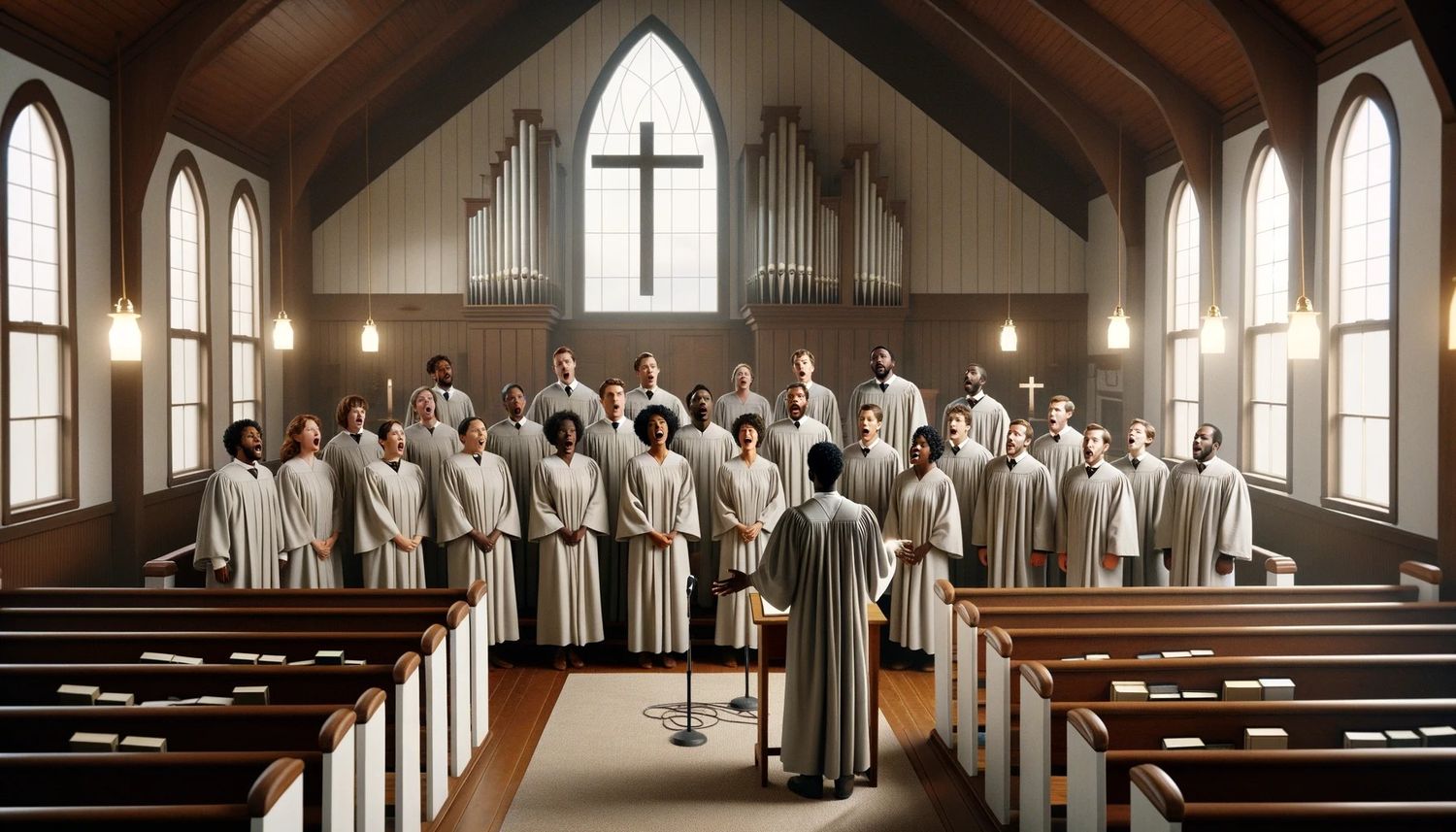Home>Arts and Culture>What Are Praise Hymns


Arts and Culture
What Are Praise Hymns
Published: March 7, 2024
Peter Smith, Editorial Director at Christian.net, combines deep insights into faith, politics, and culture to lead content creation that resonates widely. Awarded for his contributions to religious discourse, he previously headed a major organization for religious communicators, enhancing dialogue on faith's societal impacts.
Discover the rich history and significance of praise hymns in the arts and culture. Explore the impact of these musical expressions on faith and tradition.
(Many of the links in this article redirect to a specific reviewed product. Your purchase of these products through affiliate links helps to generate commission for Christian.net, at no extra cost. Learn more)
Table of Contents
The History of Praise Hymns
Praise hymns have a rich and diverse history that dates back centuries. The tradition of singing hymns as a form of praise and worship can be traced to ancient civilizations, including the Hebrews in the Old Testament and early Christians in the New Testament. The Psalms, for example, are a collection of hymns and songs that were used in the worship practices of the ancient Hebrews. These hymns were often accompanied by musical instruments and were an integral part of religious ceremonies and rituals.
During the Protestant Reformation in the 16th century, the use of hymns in Christian worship underwent a significant transformation. Reformers such as Martin Luther and John Calvin advocated for congregational singing in the vernacular language, which led to the creation of numerous hymns that were accessible to the common people. This marked a shift from the exclusive use of Latin in church music to the inclusion of hymns in the native languages of the worshippers.
The 18th and 19th centuries saw a proliferation of hymnody, with the publication of hymnals containing a wide variety of praise hymns. Influential hymn writers such as Isaac Watts, Charles Wesley, and Fanny Crosby composed hymns that are still sung in churches today. These hymns reflected the theological and doctrinal emphases of different Christian denominations and contributed to the development of distinct hymn traditions within various branches of Christianity.
In more recent history, the 20th and 21st centuries have witnessed the emergence of contemporary praise and worship music, characterized by a blend of traditional hymnody and modern musical styles. This evolution has given rise to a new generation of praise hymns that resonate with diverse congregations and cater to changing musical preferences. The history of praise hymns is a testament to their enduring significance in the expression of faith and the communal worship experience.
Read more: What Are Advent Hymns
The Purpose of Praise Hymns
Praise hymns serve multiple purposes within the context of religious worship and communal gatherings. These purposes are deeply rooted in the spiritual, emotional, and communal dimensions of the human experience. Here are some of the key purposes of praise hymns:
-
Expressing Devotion and Adoration: Praise hymns provide a means for individuals and congregations to express their devotion and adoration to the divine. Through the lyrics and melodies of hymns, worshippers articulate their reverence, love, and awe for the object of their faith. This expression of devotion fosters a sense of intimacy and connection with the divine presence.
-
Teaching and Proclaiming Truth: Praise hymns often convey theological truths, biblical narratives, and doctrinal principles in a poetic and memorable form. They serve as a vehicle for teaching and proclaiming the foundational beliefs of a religious tradition. The repetition of key themes and messages in hymns reinforces the doctrinal identity of a faith community and aids in the retention of spiritual knowledge.
-
Fostering Unity and Fellowship: Singing praise hymns collectively fosters a sense of unity and fellowship among worshippers. The act of joining voices in harmony creates a communal bond that transcends individual differences and unites diverse members of a congregation in a shared spiritual experience. This communal aspect of hymn singing promotes a sense of belonging and solidarity within religious communities.
-
Inspiring Hope and Encouragement: Praise hymns often contain themes of hope, encouragement, and assurance. In times of adversity, the lyrics of hymns can uplift and inspire individuals, offering them solace and strength. The melodies and words of these hymns have the power to instill a sense of optimism and resilience, reminding worshippers of the enduring faithfulness of the divine.
-
Facilitating Personal Reflection and Meditation: Hymn singing provides an opportunity for personal reflection and meditation. The introspective nature of some hymns encourages worshippers to contemplate their spiritual journey, express their innermost feelings, and engage in a dialogue with the divine. This introspection can lead to moments of spiritual insight and personal transformation.
-
Enhancing the Atmosphere of Worship: Praise hymns contribute to the creation of a reverent and worshipful atmosphere within religious gatherings. The combination of music, lyrics, and congregational participation elevates the spiritual ambiance, setting the stage for meaningful encounters with the divine. Hymns have the capacity to evoke a sense of transcendence and sacredness, enhancing the overall worship experience.
In essence, the purpose of praise hymns extends beyond mere musical expression; it encompasses the spiritual edification, communal bonding, and transformative impact that these hymns have on individuals and religious communities.
Characteristics of Praise Hymns
Praise hymns possess distinctive characteristics that set them apart as a genre of religious music. These characteristics contribute to the emotive, spiritual, and communal aspects of hymn singing, shaping the worship experience in profound ways. Here are the key characteristics of praise hymns:
-
Lyrical Emphasis on Praise and Adoration: Praise hymns are characterized by their lyrical focus on praising and adoring the divine. The lyrics often exalt the attributes, goodness, and majesty of the object of worship, expressing reverence and gratitude. Through poetic language and imagery, hymns articulate the sentiments of awe and devotion that define the worshipper's relationship with the divine.
-
Melodic Simplicity and Accessibility: Praise hymns typically feature melodies that are straightforward and accessible to congregational singing. The simplicity of the tunes allows worshippers of varying musical abilities to participate in the singing, fostering a sense of inclusivity and unity within the congregation. Catchy and memorable melodies enable hymns to be easily retained and sung from memory.
-
Theological Depth and Scriptural Alignment: Many praise hymns exhibit theological depth and are aligned with scriptural themes and narratives. The lyrics often draw from biblical passages and theological concepts, conveying profound truths in a concise and poetic manner. This theological richness enables hymns to serve as vehicles for spiritual instruction and reflection.
-
Emotional Resonance and Expressiveness: Praise hymns evoke emotional resonance and expressiveness, allowing worshippers to engage with their faith on a deeply personal and emotive level. The melodies and lyrics of hymns elicit a range of emotions, from joy and exuberance to introspection and contrition. This emotional dimension of hymnody facilitates a holistic and authentic worship experience.
-
Suitability for Corporate Worship: Praise hymns are designed for congregational singing and are well-suited for corporate worship settings. The inclusive nature of hymn singing encourages active participation from the entire assembly, fostering a sense of communal engagement and shared worship. The repetitive and easily singable nature of hymns facilitates collective worship expression.
-
Timelessness and Enduring Appeal: Many praise hymns exhibit a timeless quality and possess enduring appeal across generations. These hymns transcend cultural and temporal boundaries, resonating with worshippers from diverse backgrounds and ages. Their enduring popularity reflects their ability to capture universal aspects of the human experience and faith journey.
-
Integration of Traditional and Contemporary Elements: Contemporary praise hymns often integrate traditional hymnody with modern musical elements, blending the rich heritage of hymn singing with contemporary expressions of worship. This fusion of traditional and contemporary styles accommodates diverse musical preferences within congregations, ensuring relevance and resonance with contemporary worshippers.
In essence, the characteristics of praise hymns encompass their lyrical, melodic, theological, emotional, and communal dimensions, making them a vital and integral component of religious worship and spiritual expression.
Examples of Popular Praise Hymns
-
"Amazing Grace": This timeless hymn, written by John Newton in the 18th century, has resonated with countless worshippers across the globe. Its powerful message of redemption and the assurance of God's grace has made it a beloved anthem of faith.
-
"How Great Thou Art": With origins in a Swedish poem and a Russian melody, "How Great Thou Art" has become a cherished hymn in Christian worship. Its majestic portrayal of God's creation and the believer's response of awe and reverence has made it a staple in hymnals worldwide.
-
"Great Is Thy Faithfulness": Composed by Thomas O. Chisholm and set to music by William M. Runyan, this hymn celebrates the faithfulness of God in every season of life. Its comforting reassurance of God's steadfastness has endeared it to congregations seeking hope and encouragement.
-
"Blessed Assurance": Written by Fanny Crosby, a prolific hymn writer, "Blessed Assurance" exudes confidence in the believer's salvation and the abiding presence of Jesus. Its joyful declaration of faith has made it a cherished hymn in evangelical and charismatic worship traditions.
-
"How Deep the Father's Love for Us": This modern hymn, penned by Stuart Townend, offers a contemplative reflection on the sacrificial love of God demonstrated through the crucifixion of Jesus. Its introspective lyrics and haunting melody have made it a favorite for meditative worship settings.
-
"In Christ Alone": Co-written by Keith Getty and Stuart Townend, "In Christ Alone" has gained widespread popularity for its robust declaration of the foundational truths of the Christian faith. Its proclamation of the sufficiency and supremacy of Christ has resonated with congregations seeking doctrinally rich hymnody.
-
"10,000 Reasons (Bless the Lord)": This contemporary praise hymn, popularized by Matt Redman, has become a modern worship anthem. Its expression of gratitude and praise, inspired by the Psalms, has made it a staple in worship services and gatherings focused on exuberant praise.
-
"Holy, Holy, Holy": Regarded as a classic hymn of adoration, "Holy, Holy, Holy" by Reginald Heber captures the awe and reverence due to the triune God. Its timeless lyrics and majestic melody have secured its place as a revered hymn in liturgical and traditional worship contexts.
-
"It Is Well with My Soul": The poignant story behind this hymn, written by Horatio Spafford amidst personal tragedy, adds depth to its profound message of peace and trust in God's sovereignty. Its enduring message of faith in the midst of trials has made it a source of comfort for generations.
-
"Shout to the Lord": Penned by Darlene Zschech, "Shout to the Lord" has become a globally recognized worship song, known for its exuberant expression of praise and adoration. Its uplifting and declarative lyrics have made it a staple in contemporary worship repertoires.
These examples represent a mere fraction of the vast treasury of praise hymns that have enriched the worship experiences of diverse Christian communities throughout history and continue to do so in the present day.
The Role of Praise Hymns in Worship Services
Praise hymns play a pivotal role in shaping the dynamics and spiritual atmosphere of worship services across various religious traditions. Their significance extends beyond mere musical accompaniment, as they contribute to the holistic worship experience and communal expression of faith. Here are the key roles of praise hymns in worship services:
-
Facilitating Corporate Worship: Praise hymns serve as a unifying force in congregational worship, enabling the assembly to collectively engage in the act of praise and adoration. The communal singing of hymns fosters a sense of unity and participation, allowing worshippers to express their shared faith and devotion in harmony.
-
Setting the Tone for Worship: Praise hymns establish the emotional and spiritual tone of worship services, creating an atmosphere conducive to reverence, joy, contemplation, or exuberant praise, depending on the thematic content of the hymns selected. The choice of hymns can shape the overall mood and focus of the worship gathering.
-
Teaching and Proclamation: Praise hymns function as vehicles for teaching and proclaiming theological truths and biblical narratives. The lyrics of hymns convey doctrinal principles, scriptural themes, and narratives of faith, serving as a form of spiritual instruction for worshippers. Through repetitive singing, these truths are reinforced and internalized by the congregation.
-
Encouraging Active Participation: Hymn singing encourages active participation from the entire assembly, transcending passive observation and inviting worshippers to engage fully in the worship experience. The act of singing hymns fosters a sense of involvement and investment in the communal expression of faith.
-
Expressing Emotions and Devotion: Praise hymns provide an outlet for the authentic expression of emotions, allowing worshippers to convey their adoration, gratitude, contrition, or joy through the medium of music and lyrics. The emotive nature of hymnody enables worshippers to engage with their faith on a deeply personal and heartfelt level.
-
Enhancing the Spiritual Ambiance: The melodies and lyrics of praise hymns contribute to the creation of a reverent and worshipful atmosphere within the worship space. The combination of music, congregational singing, and thematic content elevates the spiritual ambiance, fostering an environment conducive to encountering the divine presence.
-
Connecting with Tradition and Heritage: Praise hymns connect worshippers with the rich tradition and heritage of hymnody, providing a link to the historical and cultural expressions of faith. Singing hymns that have been cherished for generations fosters a sense of continuity with the past and reinforces the enduring legacy of faith.
-
Fostering Reflection and Response: Hymn singing prompts worshippers to reflect on the lyrical content and respond to the spiritual truths encapsulated in the hymns. The introspective nature of some hymns encourages personal contemplation, leading to moments of spiritual insight, conviction, or affirmation.
In essence, praise hymns serve as integral components of worship services, contributing to the communal, spiritual, and educational dimensions of religious gatherings. Their multifaceted roles enrich the worship experience and resonate with worshippers across diverse cultural and denominational contexts.















